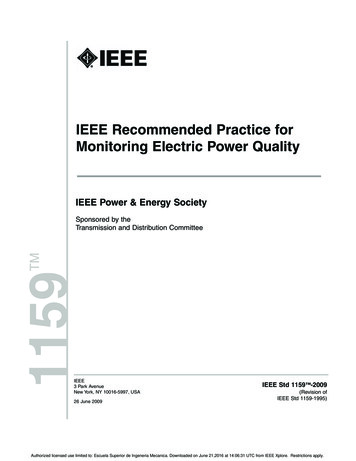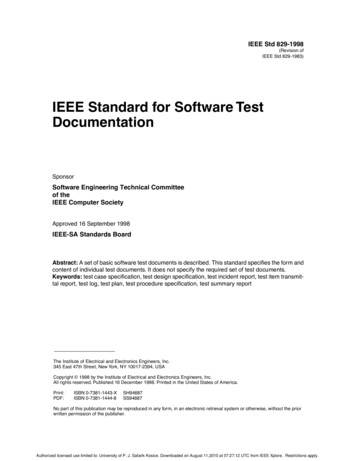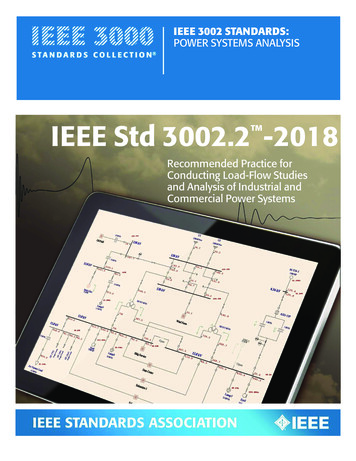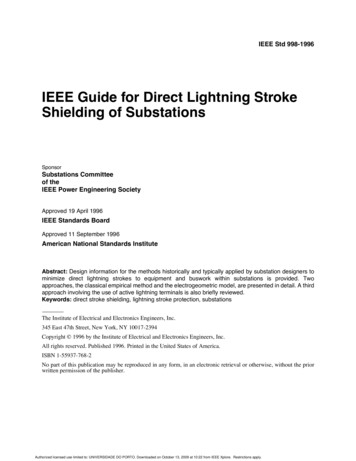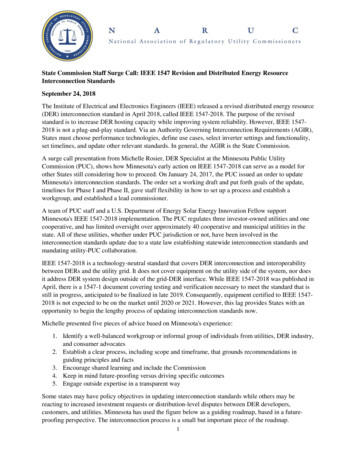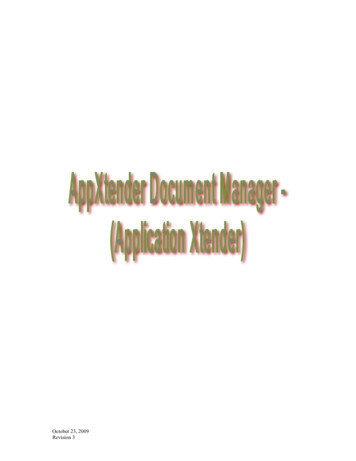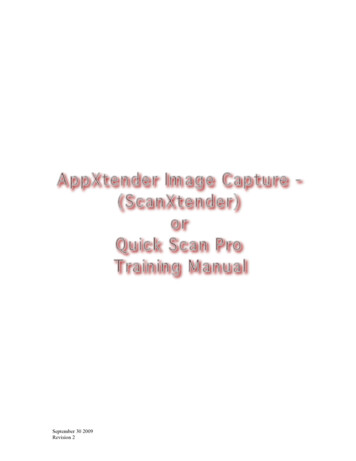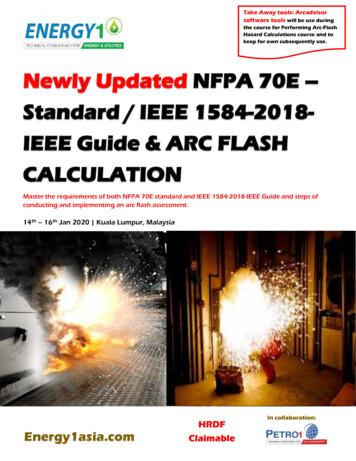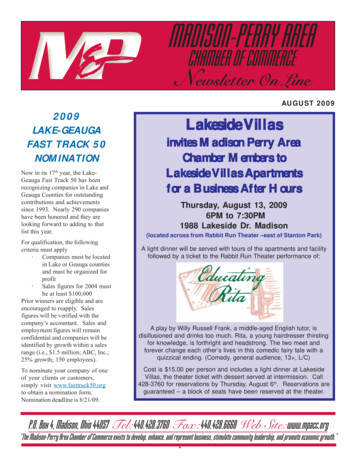
Transcription
!! ! " 01 # % & ' ( ) '( * ,) - % , . & / Authorized licensed use limited to: ULAKBIM UASL - BASKENT UNIVERSITESI. Downloaded on October 05,2010 at 13:29:11 UTC from IEEE Xplore. Restrictions apply.
Authorized licensed use limited to: ULAKBIM UASL - BASKENT UNIVERSITESI. Downloaded on October 05,2010 at 13:29:11 UTC from IEEE Xplore. Restrictions apply.
IEEE Std 1044 -2009(Revision ofIEEE Std 1044-1993)IEEE Standard Classification forSoftware AnomaliesSponsorSoftware & Systems Engineering Standards Committeeof theIEEE Computer SocietyApproved 9 November 2009IEEE-SA Standards BoardAuthorized licensed use limited to: ULAKBIM UASL - BASKENT UNIVERSITESI. Downloaded on October 05,2010 at 13:29:11 UTC from IEEE Xplore. Restrictions apply.
Abstract: This standard provides a uniform approach to the classification of software anomalies,regardless of when they originate or when they are encountered within the project, product, orsystem life cycle. Classification data can be used for a variety of purposes, including defectcausal analysis, project management, and software process improvement (e.g., to reduce thelikelihood of defect insertion and/or to increase the likelihood of early defect detection).Keywords: anomaly, bug, classification, defect, error, failure, fault, problem The Institute of Electrical and Electronics Engineers, Inc.3 Park Avenue, New York, NY 10016-5997, USACopyright 2010 by the Institute of Electrical and Electronics Engineers, Inc.All rights reserved. Published 7 January 2010. Printed in the United States of America.IEEE is a registered trademark in the U.S. Patent & Trademark Office, owned by the Institute of Electrical and ElectronicsEngineers, Incorporated.CMMI and Capability Maturity Model Integrated are registered trademarks in the U.S. Patent & Trademark Office, owned by the CarnegieMellon Software Engineering Institute.UML is a registered trademark in the U.S. Patent & Trademark Office, owned by the Object Management Group.PDF:Print:ISBN 978-0-7381-6114-3ISBN 978-0-7381-6115-0STD95995STDPD95995No part of this publication may be reproduced in any form, in an electronic retrieval system or otherwise, without the prior written permissionof the publisher.Authorized licensed use limited to: ULAKBIM UASL - BASKENT UNIVERSITESI. Downloaded on October 05,2010 at 13:29:11 UTC from IEEE Xplore. Restrictions apply.
IEEE Standards documents are developed within the IEEE Societies and the Standards Coordinating Committees ofthe IEEE Standards Association (IEEE-SA) Standards Board. The IEEE develops its standards through a consensusdevelopment process, approved by the American National Standards Institute, which brings together volunteersrepresenting varied viewpoints and interests to achieve the final product. Volunteers are not necessarily members of theInstitute and serve without compensation. While the IEEE administers the process and establishes rules to promotefairness in the consensus development process, the IEEE does not independently evaluate, test, or verify the accuracyof any of the information or the soundness of any judgments contained in its standards.Use of an IEEE Standard is wholly voluntary. The IEEE disclaims liability for any personal injury, property or otherdamage, of any nature whatsoever, whether special, indirect, consequential, or compensatory, directly or indirectlyresulting from the publication, use of, or reliance upon this, or any other IEEE Standard document.The IEEE does not warrant or represent the accuracy or content of the material contained herein, and expresslydisclaims any express or implied warranty, including any implied warranty of merchantability or fitness for a specificpurpose, or that the use of the material contained herein is free from patent infringement. IEEE Standards documentsare supplied “AS IS.”The existence of an IEEE Standard does not imply that there are no other ways to produce, test, measure, purchase,market, or provide other goods and services related to the scope of the IEEE Standard. Furthermore, the viewpointexpressed at the time a standard is approved and issued is subject to change brought about through developments in thestate of the art and comments received from users of the standard. Every IEEE Standard is subjected to review at leastevery five years for revision or reaffirmation, or every ten years for stabilization. When a document is more than fiveyears old and has not been reaffirmed, or more than ten years old and has not been stabilized, it is reasonable toconclude that its contents, although still of some value, do not wholly reflect the present state of the art. Users arecautioned to check to determine that they have the latest edition of any IEEE Standard.In publishing and making this document available, the IEEE is not suggesting or rendering professional or otherservices for, or on behalf of, any person or entity. Nor is the IEEE undertaking to perform any duty owed by any otherperson or entity to another. Any person utilizing this, and any other IEEE Standards document, should rely upon his orher independent judgment in the exercise of reasonable care in any given circumstances or, as appropriate, seek theadvice of a competent professional in determining the appropriateness of a given IEEE standard.Interpretations: Occasionally questions may arise regarding the meaning of portions of standards as they relate tospecific applications. When the need for interpretations is brought to the attention of IEEE, the Institute will initiateaction to prepare appropriate responses. Since IEEE Standards represent a consensus of concerned interests, it isimportant to ensure that any interpretation has also received the concurrence of a balance of interests. For this reason,IEEE and the members of its societies and Standards Coordinating Committees are not able to provide an instantresponse to interpretation requests except in those cases where the matter has previously received formal consideration.A statement, written or oral, that is not processed in accordance with the IEEE-SA Standards Board Operations Manualshall not be considered the official position of IEEE or any of its committees and shall not be considered to be, nor berelied upon as, a formal interpretation of the IEEE. At lectures, symposia, seminars, or educational courses, anindividual presenting information on IEEE standards shall make it clear that his or her views should be considered thepersonal views of that individual rather than the formal position, explanation, or interpretation of the IEEE.Comments for revision of IEEE Standards are welcome from any interested party, regardless of membership affiliationwith IEEE. Suggestions for changes in documents should be in the form of a proposed change of text, together withappropriate supporting comments. Recommendations to change the status of a stabilized standard should include arationale as to why a revision or withdrawal is required. Comments and recommendations on standards, and requestsfor interpretations should be addressed to:Secretary, IEEE-SA Standards Board445 Hoes LanePiscataway, NJ 08854USAAuthorization to photocopy portions of any individual standard for internal or personal use is granted by The Instituteof Electrical and Electronics Engineers, Inc., provided that the appropriate fee is paid to Copyright Clearance Center.To arrange for payment of licensing fee, please contact Copyright Clearance Center, Customer Service, 222 RosewoodDrive, Danvers, MA 01923 USA; 1 978 750 8400. Permission to photocopy portions of any individual standard foreducational classroom use can also be obtained through the Copyright Clearance Center.Authorized licensed use limited to: ULAKBIM UASL - BASKENT UNIVERSITESI. Downloaded on October 05,2010 at 13:29:11 UTC from IEEE Xplore. Restrictions apply.
IntroductionThis introduction is not part of IEEE Std 1044-2009, IEEE Standard Classification for Software Anomalies.This standard provides a uniform approach to the classification of software anomalies, regardless of whenthey originate or when they are encountered within the project, product, or system life cycle. Classificationdata can be used for a variety of purposes, including defect causal analysis, project management, andsoftware process improvement (e.g., to reduce the likelihood of defect insertion and/or to increase thelikelihood of early defect detection).Collecting the data described in this standard provides valuable information that has many usefulapplications. It is also well documented that the earlier within the software life cycle a problem isdiscovered, the cheaper, and often easier, it is to fix. This encourages the use of tools, techniques, andmethodologies to find problems sooner. Standard anomaly data are necessary to evaluate how well thesetools, techniques, and methodologies work. These data can also identify when in a project’s life cycle mostproblems are introduced. Distinctions between enhancements and problems in the software help make thedecisions as to which anomalies are addressed first, categories of funding, and so on. Anomaly data canalso assist in the evaluation of quality attributes such as reliability and productivity.Having a standard way of classifying software anomalies is important. First, it enables insight into the typesof anomalies that organizations produce during development of their products. This information is a richsource of data that can be used during the execution of a project and for process improvement. Analyticaltechniques such as Orthogonal Defect Classification and causal analysis depend on classification ofanomalies to identify root causes and to help determine means to prevent their recurrence. Processimprovement frameworks such as Capability Maturity Model Integrated (CMMI )a promote the need fordetailed understanding of process performance and product quality. The classification of anomalies allowsthe development of profiles of anomalies produced by various development processes as one indicator ofprocess performance.Second, having a standard way to classify anomalies enables better communication and exchange ofinformation regarding anomalies among developers and organizations. Unfortunately, people frequentlyassociate different meanings with the same words and/or use different words to mean the same thing.Similarly, if software systems are to communicate (i.e., exchange data) effectively regarding anomalies,they must share a common logical (if not physical) data model. Data exchange may still be possible viasome mapping or translation method if the same data elements are named differently in one system ascompared with another, but each system must at least recognize and implement the same conceptualobjects/entities, relationships, and attributes.This standard is based on several concepts and definitions that must be clearly understood prior to its use.These are discussed briefly in the following paragraphs. Formal definitions can be found in Clause 2, and itis advisable to read them before proceeding.The word “anomaly” may be used to refer to any abnormality, irregularity, inconsistency, or variance fromexpectations. It may be used to refer to a condition or an event, to an appearance or a behavior, to a form ora function. The 1993 version of IEEE Std 1044TM characterized the term “anomaly” as a synonym for error,fault, failure, incident, flaw, problem, gripe, glitch, defect, or bug, essentially deemphasizing anydistinction among those words. Such usage may be common practice in everyday conversation where theinherent ambiguity is mitigated by the richness of direct person-to-person communication, but it is notconducive to effective communication by other (especially asynchronous) methods. Because a term withsuch a broad meaning does not lend itself to precise communication, more specific terms are defined andused herein to refer to several more narrowly defined entities. Each entity has associated with it a name, aaCMMI and Capability Maturity Model Integrated are registered trademarks in the U.S. Patent & Trademark Office, owned by theCarnegie Mellon Software Engineering Institute. This information is provided for the convenience of users of this standard and doesnot constitute an endorsement by the IEEE of these products.ivCopyright 2010 IEEE. All rights reserved.Authorized licensed use limited to: ULAKBIM UASL - BASKENT UNIVERSITESI. Downloaded on October 05,2010 at 13:29:11 UTC from IEEE Xplore. Restrictions apply.
definition, a set of attributes, and a set of relationships to other entities. These entities are depicted inFigure 1 and again (using a different notation) in Figure 2, and their definitions can be found in Table 3.The relationships between key entities are modeled in the form of an entity relationship diagram (ERD) inFigure 1 and again in the form of a Unified Modeling Language (UML )b class diagram in Figure 2. Adetailed explanation of these widely used modeling notations is outside the scope of this standard; however,a brief description of each is provided below the corresponding diagram. Text descriptions of therelationships are available in Table 1, so a complete understanding of the diagrams is not essential tounderstanding this standard. The entities “Failure,” “Defect,” and “Fault” within the area labeled “IEEE1044 Scope” in Figure 1 and Figure 2 are the subject of this standard, and the other entities in the diagramsare outside the scope of this standard. Faults are considered a subtype of defect and as such are classifiedusing the same attributes as defects (see Table 4).To increase flexibility and allow organizations to adapt the classification to their own life cycles andpurposes, the following changes have been made to the previous edition of this sta
PDF: ISBN 978-0-7381-6114-3 STD95995 Print: ISBN 978-0-7381-6115-0 STDPD95995 No part of this publication may be reproduced in any form, in an electronic retrieval system or otherwise, without the prior written permission of the publisher. Authorized licensed use limited to: ULAKBIM UASL - BASKENT UNIVERSITESI. Downloaded on October 05,2010 at 13:29:11 UTC from IEEE Xplore. Restrictions

